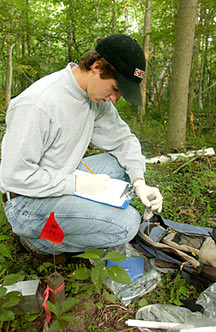Table of Contents
Turn Left in Bismarck, and Go Until…
Granting Research
Relax! We Have New Labs for That
Fieldwork Across the Curriculum:
Update on ISEI
Letter from James Costopoulos '83
Granting Research
Throughout the sciences, St. Lawrence’s faculty are winning diverse research grants in record numbers.
Jeromy Chamberlin '03 processes a deer mouse as part of preliminary data collection that set the stage for an ultimately successful grant proposal to the Fish and Wildlife Foundation by Fippinger Assistant Professor of Biology Erika Barthlemess. By Neal S. Burdick ’72
St. Lawrence must not get a lot of grants for scientific research, since it’s a liberal arts university, not a technical institute, right?
Way wrong. As the accompanying chart shows, the University has in recent history had a growing abundance of such grants, many of them bridging the disciplines and even stretching past the boundaries of the traditional sciences. From the vaunted National Science Foundation and National Institutes of Health, to the more localized Black Lake Association and Lake Champlain Research Consortium, St. Lawrence is on the radar screens of a great many providers of funds for scientific research—providers who do not hand out six and seven figures to just any old college.Assistant Professor of Chemistry Jeffery Greathouse says he and his students are using computer simulation techniques to study how radioactive elements such as uranium interact with minerals in a groundwater environment. “This research has particular relevance to the proposed nuclear waste disposal site at Yucca Mountain, Nevada,” he says.
“ A large portion of the grant money I receive pays summer stipends for student collaborators,” Greathouse continues. “I expect these students to make great contributions. They often present their results at professional conferences, and they are co-authors of articles published in scientific journals.”
In biology, Assistant Professor Joseph Erlichman is project director for several grants from the National Science Foundation and the National Institutes of Health. “My work focuses on understanding how the neural circuits in the brainstem regulate breathing,” he says.
“My research is done with a team of wonderfully dedicated students,” Barthelmess says. “My research and my teaching greatly overlap. In fact, I cannot conduct my research without help from students. My students are not just ‘grunts’ but are involved in all aspects of the research, from experimental design, to data collection and analysis, to writing up the results.” In fact, one of those students, Jolaine Roycewicz ’03, Hudson Falls, N.Y., was herself awarded a small grant from the national science and engineering honor society Sigma Xi for her part in the project.
Assistant Professor of Chemistry Ning Gao’s grant-funded research project provides what she calls a “much-needed probe into different pathways of mercury deposition into Lake Champlain. Bioaccumulation of mercury, a neurotoxin, in fish in Lake Champlain,” she explains, “has led to restrictions on fish consumption. Our findings and the mass balance model developed will be very useful tools for environmental quality management.”
In geology, Assistant Professor Stephen Robinson gets even farther afield. Last summer, he and research assistant Diana Odorczuk '03, Harwinton, Conn., flew to Edmonton, Alberta, and then drove north for two days to a research site in the Northwest Territories. They were funded by a grant from Natural Resources Canada to study the “Influence of Permafrost on Northern Forested Peatlands."
